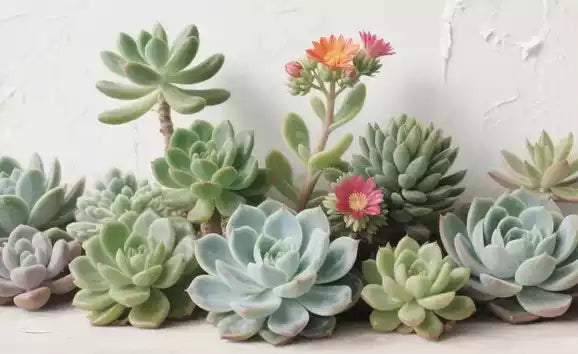
Must-Read! The Truth About Feeding Succulents
Hey, succulent lovers! Every time you see those round, adorable succulents on your windowsill, doesn’t it fill you with joy? But as you care for them, have you ever wondered: do these little cuties need extra “snacks”? Today, we’ll finally clear up this mystery!
Succulents’ Survival Instinct: Self-Sufficient “Little Savings Jars”
Succulents are true “survival masters” of the plant world. Consider the vast deserts of the American Southwest and the Rocky Mountains of Colorado—these harsh environments are the natural habitats of many succulents. There, the soil is so nutrient-poor that it’s almost barren, yet succulents thrive thanks to their unique survival skills. They have evolved thick leaves and stems, acting like little “savings jars” filled with water and nutrients, enabling them to sustain themselves under extreme conditions. So even if you forget to ‘feed’ your succulents for several months, they can survive on their own “little storage units.”

Proper Feeding: The Secret to Enhancing Succulent Aesthetics
However, if you want your succulents to look even more vibrant—with fuller leaves, more vibrant colors, and even beautiful flowers—proper fertilization is still necessary. This is akin to how we can survive on fast food daily, but occasionally enjoying a nutritious, carefully prepared meal can leave us feeling energized. Succulents are no different; moderate fertilization can enhance their overall condition.
Timing Fertilization: Follow the Succulent's “Biological Clock”
When should you give your succulents an extra “meal”? In fact, succulents also have their own “biological clock.” During spring and summer, when sunlight is abundant and temperatures are suitable, it is the peak growing season for succulents. Just as children need more nutrients during their growth phase, succulents also have significantly increased nutrient requirements during this period, making it the optimal time for fertilization. In autumn, as temperatures drop, succulents begin to grow more slowly; by winter, many varieties enter dormancy, with growth virtually ceasing. Fertilizing at this time is not only ineffective but may also “do more harm than good,” damaging the succulent's root system, so it is essential to resist the urge to fertilize!
Fertilizer selection guide: DIY
Using well-decomposed coffee grounds (common in households where coffee is regularly consumed) mixed with a small amount of eggshell powder makes an excellent organic fertilizer. However, it is crucial to ensure the coffee grounds are fully decomposed. Apply a thin layer on the soil surface, avoiding direct contact with the roots. When fertilizing, water along the edge of the pot to prevent fertilizer from splashing onto the leaves and causing burns.

Fertilization Tips: Assess Needs, Apply in Small Amounts Multiple Times
Here’s another practical tip. If you notice your succulents’ leaves turning pale and wilted, and their once compact form becoming loose, and after ruling out watering and lighting issues, it’s likely a nutrient deficiency. However, when fertilizing, remember the principle of “less is better than more,” adhering to the “small amounts, frequent applications” approach. If unsure about the amount, start with half the recommended dose for the first application, observe for a few weeks, then adjust based on the plant's condition.
Ultimately, whether to fertilize succulents depends on your expectations. As long as you master the timing and method of fertilization, your succulents will thrive in their pots, becoming the most eye-catching green plants in your home!
Share